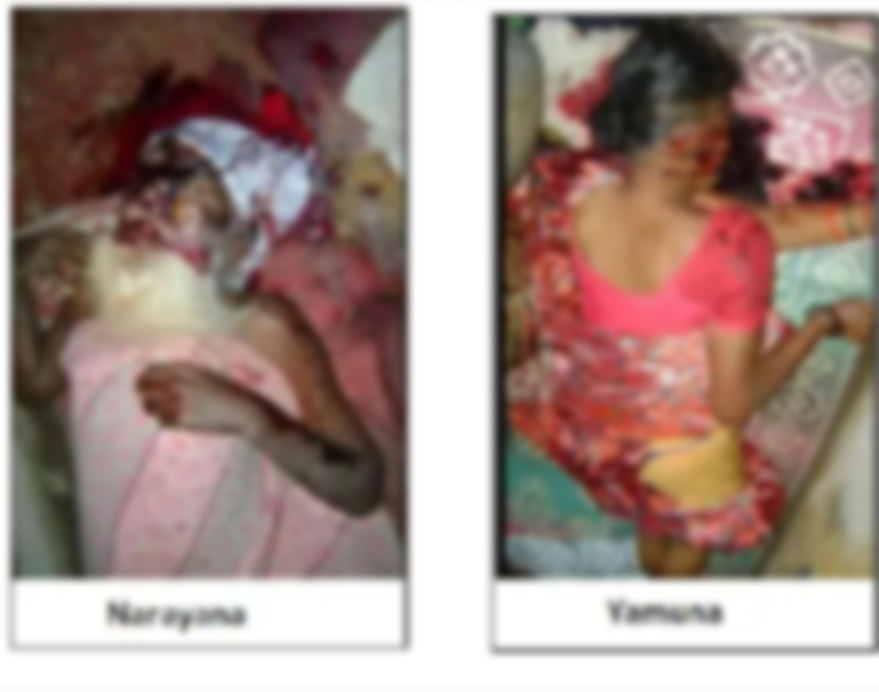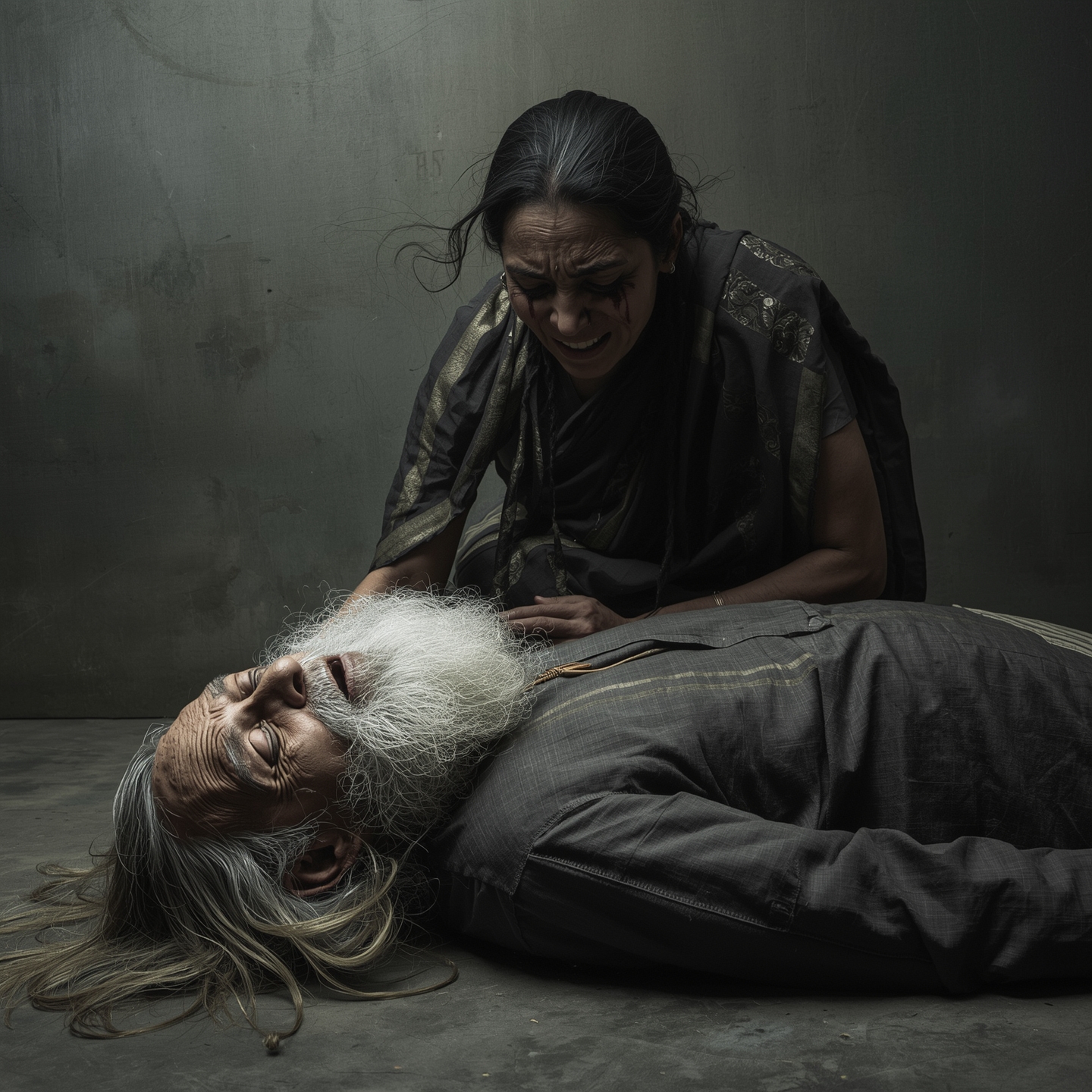By Srinivas Rayappa
Content warning: This article contains descriptions of violence, murder, and investigative details that readers may find disturbing.
The Mahout Who Wouldn’t Move
For four generations, the men of Narayan’s family had served as mahouts at the Dharmasthala temple, tending to the elephants that were as much a part of the temple’s grandeur as its golden kalashas. Their small house near the KSRTC bus stand had stood for 400 years—a testament to their family’s deep roots in this sacred soil. In a rapidly changing Dharmasthala, where ancient pathways were giving way to modern highways and traditional homes were being replaced by multi-story hotels, Narayan’s modest dwelling represented something increasingly rare: a refusal to be erased.
By 2012, the 65-year-old former mahout had become more than just an inconvenience to those seeking to expand Dharmasthala’s infrastructure. He had become a symbol of resistance—a man who wouldn’t sell his birthright, no matter the pressure, no matter the price, no matter the consequences.
On the night of September 20, 2012, those consequences arrived with crushing finality.
A Festival Night Turned Fatal
As Dharmasthala celebrated with an orchestra function at the KSRTC bus stand—part of the ongoing Ganesha Festival celebrations—the sounds of devotion and joy masked a scene of calculated brutality just meters away. Inside their home, Narayan and his 45-year-old sister Yamuna were murdered with a savagery that would shock even a community increasingly numbed to violence.
Narayan’s head was crushed with a massive grinding stone—the very kind used to prepare spices in traditional kitchens. Yamuna’s skull was smashed with a heavy rock. The weapons chosen seemed deliberately primitive, as if to send a message that this was not just murder, but annihilation.

The bodies were discovered the next morning around noon, when concerned neighbors finally entered the house. What they found was a scene that local sources would later describe as a “planned execution, carried out silently under cover of festival noise.”
Just 20 days later, 17-year-old Soujanya would meet her own tragic end in the same region—a case we have explored in “The Shadow of Dharmasthala: Unraveling the Soujanya Case“. The proximity of these murders was not lost on those who understood the patterns at play.
The Price of Progress
To understand why Narayan died, one must first understand what Dharmasthala had become—and what it demanded of those who stood in its path.
Once a small temple town visited by devoted pilgrims seeking the blessings of Lord Manjunatha, Dharmasthala had transformed into one of Karnataka’s most significant religious tourism destinations. With this growth came an insatiable hunger for land. New facilities were constantly needed: accommodation complexes for the thousands of daily visitors, expansive dining halls to feed them, parking lots for their vehicles, marriage halls for auspicious ceremonies, hotels for those who could afford comfort, shops selling everything from prayer items to souvenirs, healthcare facilities, water treatment plants, security infrastructure, and ever-widening roads to handle the traffic.
According to local accounts, as the temple’s land requirements grew, so did the pressure on those who owned property in strategic locations. The conflict was as old as civilization itself: those who had lived on the land for generations versus those who claimed a higher purpose for it.
Narayan’s house sat on prime real estate—right next to the KSRTC bus stand, in the heart of the pilgrimage circuit. For those planning Dharmasthala’s expansion, his refusal to sell wasn’t just an inconvenience; it was an obstacle to progress, a stubborn reminder that not everything could be bought.
A Campaign of Torment
According to accounts from Narayan’s family and local sources, what followed was a systematic campaign to make life unbearable for the elderly mahout.
The harassment allegedly began with what might seem like infrastructure failures but were reportedly deliberate acts:
Sewage as a Weapon: Villagers claim that sewage was deliberately directed to flow in front of Narayan’s house, creating an unbearable stench. Day after day, the family lived with the smell of human waste at their doorstep—a daily reminder that they were unwanted.
Water Denied: In an act of particular cruelty, Narayan was reportedly denied access to the open well near his house—his family’s only source of water. The man who had spent his life serving the temple was forced to carry water from several kilometers away, just to drink, cook, and bathe. In the scorching heat of coastal Karnataka, this wasn’t just harassment; it was a slow attempt at making life impossible.
Violence and Threats: Local sources allege that Narayan faced constant abuse, threats, and physical beatings. The message was clear: leave voluntarily, or be forced out.
Unable to bear these conditions, Narayan’s wife made the painful decision to take their children and move to her sister’s house. But Narayan refused to abandon his ancestral home.
It was then that his sister Yamuna, described by various sources as partially mentally unstable but fiercely loyal, came to live with him. She would cook, clean, and provide companionship to her brother in what would become their final days together.
The Land They Died For
According to a complaint filed by Sundri, Narayan’s wife, to the Superintendent of Police, Mangalore, the family had been facing threats for several days before the murder. The name mentioned in her complaint was Rajendra Rai, who allegedly had connections to influential groups and had made repeated threats to their family, pressuring them to vacate the land.
In a subsequent complaint to the police, as reported by ThePrint, Sundri alleged that Veerendra Heggade’s brother, Harshendra, had visited their home and threatened them on the same issue. It should be noted that no formal charges were filed based on these allegations.
Ganesh, Narayan’s son, would later tell The Federal Karnataka: “We refused to give away our ancestral home of 400 years, and my father and aunt were killed for that.”
His words carried the weight of not just personal loss but historical injustice—a family’s centuries-old connection to the land severed by violence.
The Investigation That Wasn’t
If the murder was brutal, the investigation that followed was farcical.
According to multiple media reports, the police immediately labeled the case as dacoity—a robbery gone wrong. This classification raises questions that even a cursory examination should have answered:
The Poverty Problem: Which dacoit would target Narayan, a poor former mahout who could barely afford to feed himself? His wife had already left with their children, taking whatever few valuables the family possessed. Yamuna, described as vagrant-like and mentally unstable by some accounts, owned nothing of value.
The Missing Jewels: Police claimed jewels were stolen. But as locals pointed out, when Sundri left for her sister’s house, she would have taken whatever little jewelry the family owned. Why would she leave valuables in a house under siege?
The Timing: The murder occurred during a public festival, with hundreds of people nearby. Professional dacoits typically avoid such high-risk situations.
The Brutality: The excessive violence—crushing skulls with grinding stones and rocks—suggested personal animosity, not the clinical efficiency of robbers who simply wanted to steal and escape.
As one local resident reportedly asked: “Which foolish dacoit would want to steal from a poor mahout who couldn’t afford to put food on his plate?”
Despite these glaring inconsistencies, the police persisted with the dacoity theory. No meaningful investigation was conducted. No arrests were made. The case was eventually closed with what activists familiar with the region call a “classic C report”—neither solved nor seriously investigated.
The same police officer who handled this investigation would later be responsible for the Soujanya case, which was similarly bungled. As Ganesh bitterly observed: “If the police had acted properly, Soujanya might still be alive. We request the SIT to take up our case too.”
Erased From the Map
What happened next revealed the true motive behind the murders—and exposed the calculated nature of what the police had dismissed as random dacoity.
According to family members, most of the documents in Narayan’s house were destroyed during the alleged “dacoity”—a convenient detail that would complicate any future land ownership claims. Property papers, title deeds, family records that proved four centuries of residence—all reportedly vanished in what was supposedly a simple robbery.
The legal question that should have been asked but never was: How did the land change hands so quickly?
Under Indian succession laws, Narayan’s property should have automatically passed to his legal heirs—his wife Sundri and their children. Even if Narayan had died intestate (without a will), the Hindu Succession Act clearly establishes that his wife and children would be the rightful inheritors of his ancestral property. No sale could legally occur without their consent and signature.
Yet within two months of the murders, their 400-year-old house was completely demolished. The land that Narayan had died defending was somehow acquired by the temple management, according to local accounts. Today, in that same spot where two innocent people were murdered, stands Hotel Ayodya Aatithya—a multi-story establishment serving pilgrims.
The questions multiply:
- How was the land transferred without the legal heirs’ consent?
- What documents enabled this transfer when the originals were allegedly destroyed in the “dacoity”?
- Why didn’t authorities investigate this suspicious and rapid change of ownership?
- How did a “robbery” so conveniently serve the interests of those who had been pressuring Narayan to sell?
As one local activist observed: “The dacoits seemed remarkably interested in property documents for criminals who supposedly came for jewels. And remarkably efficient in ensuring the land could be acquired quickly after the murders.”
Not a single memorial marks the spot. Not a single nameboard remembers the mahout and his sister. Not a trace of justice remains.
Just concrete poured over blood—and a hotel built on stolen land.
The Pattern Continues: Question Authority, Pay With Your Life
The murder of Narayan and Yamuna fits disturbingly well into the pattern we have documented throughout this series—a pattern that reveals a simple, terrifying equation: Question or resist authority in Dharmasthala, and you will be finished.
Like Vedavalli Harale in 1979, Narayan dared to challenge the powerful. Vedavalli, the teacher who questioned why she was overlooked for promotion as principal despite her qualifications, protested against the management’s caste-based decision. She stood in front of her school and raised her voice against injustice. She even secured a legal victory in her case at the Karnataka High Court—but legal victories mean nothing to those who operate outside the law. She was burnt alive in her own bathroom. Similarly, Narayan refused to bow before those who demanded his ancestral land. Both paid the ultimate price for their defiance.
The parallels with Padmalatha’s case in 1986 are equally chilling. Her father, Devanand, had prevented the eviction of villagers and dared to contest elections despite being told not to by authorities. His daughter paid for his defiance—kidnapped and found dead. Narayan, like Devanand, refused to bend before authority and vacate his property. The message in both cases was clear: resist us, and we will take what you love most.
The Soujanya case of 2012, occurring just 20 days after Narayan and Yamuna’s murder, adds another dimension to this pattern. Local whispers suggest Soujanya may have been a case of mistaken identity—that the real target was a girl named Varsha, whose family was allegedly unwilling to give up their land. If true, it reveals how rape is weaponized to silence families, how sexual violence becomes a tool of land acquisition. The innocent pay for their families’ refusal to surrender.
Even Ananya Bhat’s disappearance in 2003 fits this horrifying pattern. When her mother, Sujatha, dared to question authorities about her missing daughter, she wasn’t just dismissed—she was abducted, brutally assaulted, and left in a coma for three months. Her crime? Asking too many questions, refusing to accept the dismissive response that her daughter had “eloped.” Like Narayan, she discovered that challenging authority in Dharmasthala comes with devastating consequences.
The pattern that emerges suggests something even more sinister—a symbiotic relationship between those who hunger for land and power, and those who satisfy darker appetites. One provides cover for the other, creating a perfect storm where property acquisition and sexual violence intertwine, where murder serves multiple purposes, where every crime strengthens the grip of control over Dharmasthala.
In each case, the formula remains consistent:
- First comes the demand (for silence, for land, for submission)
- Then comes the resistance (a teacher’s protest, a father’s defiance, a mahout’s refusal, a mother’s questions)
- Finally comes the punishment (murder, rape, assault, disappearance)
- And always, always, comes the cover-up (botched investigations, destroyed evidence, intimidated witnesses)
Narayan and Yamuna’s murder wasn’t just about one piece of land. It was about sending a message to everyone in Dharmasthala: This is what happens to those who don’t cooperate. This is the price of defiance. This is the cost of saying no to progress.
The Questions That Remain
In July 2024, when the whistleblower’s revelations about mass burials in Dharmasthala shocked the nation, families of victims like Narayan and Yamuna found new hope. The Special Investigation Team (SIT) formed by the Karnataka government was seen as a chance to finally uncover the truth about decades of unsolved murders.
But the government’s decision to limit the SIT’s scope only to the mass graves case, excluding past murders like that of Narayan and Yamuna, has left families devastated. As T. Jayanth, leader of the Sowjanya Justice Committee, told The Federal: “This approach undermines justice. The SIT should also investigate old cases like those of Sowjanya, Padmalatha, Narayan, and Ananya Bhat.”
The questions remain:
- Why would dacoits target a destitute family?
- Why was the house demolished so quickly after the murders?
- Why did the same officer bungle both this case and Soujanya’s?
- How many more had to die for land?
Progress at What Cost?
Today, Dharmasthala continues to expand. New facilities rise where old homes once stood. Pilgrims arrive in ever-greater numbers, seeking divine blessings, unaware that they might be walking on land soaked in blood.
The temple town’s transformation into a modern pilgrimage-industrial complex is complete. But at what cost? How many Narayans had to be crushed? How many Yamunas had to be silenced? How many families had to be erased from the map?
Narayan spent his life serving the temple’s elephants—gentle giants who, despite their immense strength, are known for their deep family bonds and their ability to mourn their dead. It is cruelly fitting that a mahout who understood these noble creatures was himself killed for refusing to abandon his family’s land.
In the end, Narayan’s story is not just about one man’s refusal to sell his heritage. It is about what happens when development becomes predation, when progress demands blood sacrifice, when the hunger for land consumes all morality.
The Hotel Ayodya stands as a monument to this hunger—a concrete testament to how easily human lives can be erased when they stand in the way of expansion. Every brick might as well be mortared with blood, every room built on bones.
But Ganesh, Narayan’s son, refuses to let his father’s memory be buried under concrete. His demand that the SIT investigate his father’s murder is not just about one family’s quest for justice. It is about ensuring that progress in Dharmasthala—or anywhere—cannot continue to be built on a foundation of murder and fear.
For now, the shadow of Dharmasthala continues to lengthen, and the questions multiply: How many more Narayans must die before the killing stops? How many more ancestral homes must be demolished? How many more families must be scattered to the wind?
The answers lie buried—perhaps literally—in the soil of Dharmasthala. Until they are unearthed, the shadow will continue to grow, and the blood will continue to cry out from the ground, even if it is covered by the finest marble and the most modern hotels.
This is the fifth article in our ongoing series “The Shadow of Dharmasthala” examining unresolved cases in the temple town. Previous articles in this series:
- The Shadow of Dharmasthala: The Vedavalli Tragedy – The 1979 murder of teacher Vedavalli Harale who challenged caste-based discrimination
- The Shadow of Dharmasthala: Padmalatha Pays the Price of Defiance – The 1986 disappearance and murder of 17-year-old student Padmalatha
- The Shadow of Dharmasthala: The Ananya Bhat Disappearance – A Mother’s Unending Search – The 2003 disappearance of medical student Ananya Bhat
- The Shadow of Dharmasthala: Unraveling the Soujanya Case – The 2012 rape and murder of 17-year-old student Soujanya and the controversial investigation
Note: This article is based on media reports, police complaints, family testimonies, and documented accounts. Some allegations remain disputed, and the article presents multiple perspectives on these complex events while acknowledging that formal charges were not filed in many instances. The investigation into these deaths remains incomplete.


